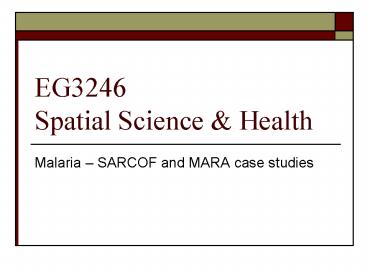EG3246 Spatial Science PowerPoint PPT Presentation
1 / 22
Title: EG3246 Spatial Science
1
EG3246Spatial Science Health
- Malaria SARCOF and MARA case studies
2
Topics
- Why model Malaria?
- What should we model?
- SARCOF
- MARA
3
Why Model Malaria?
- Poses an extreme risk to human health
- Aetiology of the disease is fairly well
understood - Malaria CAN be stopped with enough money and
political will
4
Why Model Malaria?
- Malaria is likely to become an even greater
public health problem in response to climate
change - Dominant causal factors are mediated through
climate this is monitored with new technologies
such as remote sensing and climate modelling - Powerful computers allow modelling methods to be
exploited more effectively
5
Why Model Malaria?
- Europe has been affected before
- Burden within Africa
- Economic and political instability
- Global warming threat to EU
- 21st Century quality of life
gt1M deaths a year Up to 500M cases of acute
illness a year Up to 50K cases of neurological
damage a year Up to 400K episodes of severe
anaemia in pregnancy Up to 300K low-birthweight
babies B Greenwood (2004) Nature Vol 430, 2004
6
(No Transcript)
7
What should we model?
- Environmental variables
- Rainfall
- Temperature
- Humidity
- Vegetation dynamics
- Topography
- Climate change
8
What should we model?
- Socio-economic variables
- Demographics
- Social inequality
- Poverty
- Access to basic healthcare
- Conflict and political instability
- Capacity building
9
What should we model?
- Interpolation of sparse station readings is
undesirable so we must look to - Remote sensing
- Model output
ABOVE Model grid representation LEFT Meteosat
weather satellite
10
SARCOF
- Southern
- Africa
- Regional
- Climate
- Outlook
- Forum
SARCOF data extensively used by Southern Africa
Malaria Control (SAMC)
11
SARCOF
- Fourteen countries comprising the Southern
African Development Community (SADC) Member
States - Angola, Botswana, Democratic Republic of Congo,
Lesotho, Malawi, Mauritius, Mozambique, Namibia,
Seychelles, South Africa, Swaziland, Tanzania,
Zambia, and Zimbabwe
12
SARCOF
- Facilitates information exchange and stimulates
interaction among forecasters, decision-makers
and end users - Promotes technical and scientific capacity
building in the region by producing,
disseminating and applying climate forecast
information in weather sensitive sectors of the
SADC region
13
SARCOF
- The first forum took place during the 1998/1998
rainfall season - As well as country-specific NMSs, organisations
such as UKMO, ECMWF and Euro/US scientists took
part - Forum results in consensus forecasts of the
region which are then discussed and interpreted
by end users
14
Typical consensus forecasts from SARCOF at
pre-season meeting LEFT October, November,
December 1999 RIGHT January, February, March 2000
15
RIGHT Mid-season update
16
SARCOF
- The forum now allows and encourages input from
African climate modelling groups - Each SADC nation brings their own risk map to the
table and this is incorporated into the final
forecast - World Bank, UK Government, USAID are key donors.
SARCOF has now been copied in West and East
African regions
17
MARA
- The MARA/ARMA collaboration was initiated to
provide an Atlas of malaria for Africa,
containing relevant information for rational and
targeted implementation of malaria control - Principle objective is to map malaria risk
- Through collection of published and unpublished
malaria data - Through spatial modelling of malaria
distribution, seasonality and endemicity
18
MARA
- To disseminate relevant information to national
and international decision makers and other end
users, in a range of useful formats - To develop capacity in malaria / health GIS.
19
MARA
- MARA/ARMA has provided the first continental maps
of malaria distribution and the first
evidence-base burden of disease estimates. - There is currently hardly any major document on
malaria in Africa that does not make use of MARA
maps
20
MARA Method
- Observed case data is collected from a wide a
geographical area as possible (historical records
and newly generated data) - All data is georeferenced and inserted into a
relational database - Geostatistical analyses are used in GIS linked to
the database to create spatial queries - Independent models are used to create a variety
of modelled indictors and risk factors
21
MARA Method
- Predictive modelling allows estimation of data in
areas where no empirical observations exist - Where gaps exist, interpolation methods are used
sometimes with environmental information as a
means of weighting risk - Data used is primarily
- Incidence
- Entomological Inoculation Rate (EIR)
- Parasite ratio (parasite prevalence)
22
MARA Method
- Objective is atlas providing seasonality,
endemicity and geographical specificity - A hierarchy of spatial scales is used
- Continental scale (broad, climate based)
- Sub-continental (uses ecological zones)
- Regional or national scale (ecology and climate)
- 30 km2 scale at administrative units

